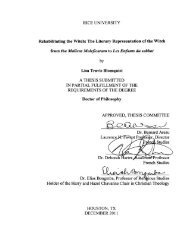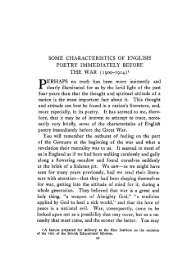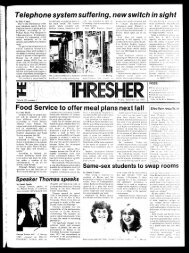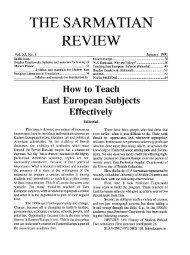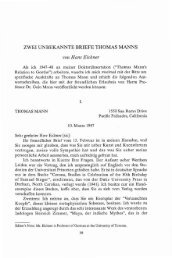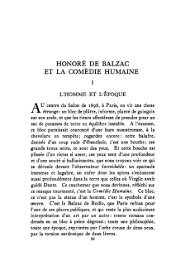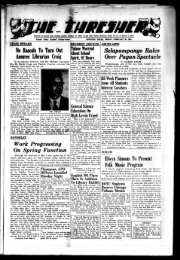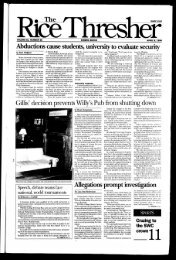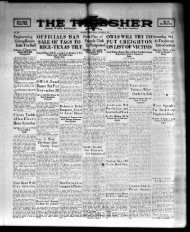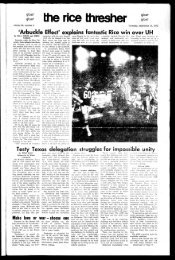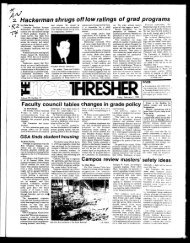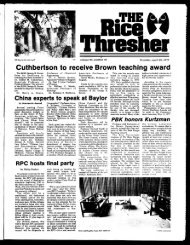The church at Las Condes
The church at Las Condes
The church at Las Condes
Create successful ePaper yourself
Turn your PDF publications into a flip-book with our unique Google optimized e-Paper software.
'V.'."'<br />
THE CHURCH AT LAS CONDES: ARCHITECTURE AT RICE 20<br />
w>.<br />
m<br />
^:-<br />
•\
<strong>The</strong> cover:<br />
". . . <strong>The</strong> sun, in its course, is reflected in the<br />
interior of our <strong>church</strong> in a variety of p<strong>at</strong>terns, with<br />
suitable changes for the hours of the day and the<br />
seasons of the year, thus giving the liturgical cycles<br />
their full existential meaning"— Brother Martin<br />
and Brother Gabriel, of the Benedictine Monastery<br />
of <strong>Las</strong> <strong>Condes</strong>, Chile.<br />
La Portada<br />
" ... El sol, en su curso, se refleja en el interior en<br />
varias formas, con los cambios propios de horas del a IV H<br />
día y las estaciones del año, dando por lo tanto '\\<br />
al ciclo litúrgico su integra y verdadera esencia."<br />
—Hermanos Gabriel y Martin, Monasterio Bene- .<br />
dictino de <strong>Las</strong> <strong>Condes</strong>, Chile.<br />
f^l<br />
'ao,:ío
THE CHURCH AT LAS CONDES: ARCHITECTURE AT RICE 20
Architecture <strong>at</strong> Rice University is a series of<br />
reports on thoughts and investig<strong>at</strong>ions from the<br />
School of Architecture. <strong>The</strong> series is published in<br />
the belief th<strong>at</strong> educ<strong>at</strong>ion of architects can best be<br />
advanced when teachers, students, practioners, and<br />
interested laymen share wh<strong>at</strong> they are thinking<br />
and doing.<br />
Arquitectura en la Universidticl de Rice es una serie<br />
de informes sobre ideas e intestigiiciones nacidas y<br />
desarrolladas en la Escuela de Arquitectura de Rice.<br />
Esta serie se publica con la convicción de que<br />
los estudios arquitectónicos se enriquecerán cuando<br />
maestros, arquitectos profesionales, estudiantes y<br />
legos interesados compartan lo que piensan y lo<br />
que hacen.<br />
By Paul A. Kennon Associ<strong>at</strong>e Director<br />
Rice University School of Architecture<br />
Tom Daly Photographer<br />
John McRae Graphic Designer<br />
Ann Mohler Editor of the Series<br />
Houston, Texas March, 1967
While directing a Rice University architectural<br />
team working in Chile under a Ford Found<strong>at</strong>ion<br />
grant. School of Architecture Associ<strong>at</strong>e Director<br />
Paul Kennon discovered an unusual monastery<br />
<strong>church</strong>, and described it in a letter to William W.<br />
Caudill, Director of the School.<br />
<strong>The</strong> <strong>church</strong>. Monasterio Benedictino de <strong>Las</strong> <strong>Condes</strong>,<br />
is a powerful and primitive architectural st<strong>at</strong>ement,<br />
modeled with stark white poured-in-place concrete<br />
and rough form boarding. Professor Kennon was<br />
impressed by the unpretentious strength of the<br />
little <strong>church</strong> — and by the masterful harnessing of<br />
n<strong>at</strong>ure to cre<strong>at</strong>e dram<strong>at</strong>ic, ever-changing light p<strong>at</strong>terns<br />
for the interior.<br />
When Professor Kennon discovered th<strong>at</strong> the building<br />
was designed by a pair of monks who live<br />
in the adjoining monastery, he asked them to write<br />
in their own words their concepts for their <strong>church</strong>.<br />
<strong>The</strong> result — commentary by the monks, photographs<br />
by Rice gradu<strong>at</strong>e student Tom Daly, and<br />
Professor Kennon's original letter describing the<br />
building — is "Monasterio Benedictino de <strong>Las</strong><br />
<strong>Condes</strong>," Architecture <strong>at</strong> Rice 20.<br />
— <strong>The</strong> Editor<br />
AUentras dirigía un gru/jo de arquitectos de Rice<br />
en Chile, que trabajaban como becados de la Ford<br />
Found<strong>at</strong>ion, Paul Kennon, Director Associado de la<br />
Escuela de Arquitectura de Rice, descubrió una<br />
extraordinaria iglesia en un monasterio y la describió<br />
en carta a William W . Caudill, Director de<br />
la Escuela.<br />
La iglesia, del Monasterio Benedictino de <strong>Las</strong> <strong>Condes</strong>,<br />
es un sólido y primitivo edificio, moldeado con<br />
hormigón fraguado totalmente blanco y riistico<br />
maderamen.<br />
Al professor Kennon le impresionó la despretenciosa<br />
fuerza de la pequeña iglesia y la magistral habilidad<br />
de la n<strong>at</strong>uraleza en crear dramáticos y siempre<br />
cambiantes efectos de luz en el interior.<br />
Cuando el profesor Kennon descubrió que el edificio<br />
había sido dibujado por un par de monjes que<br />
vivían en el tnonasterio contiguo, les pidió que<br />
describieran con sus propias palabras su concepto de<br />
la iglesita. El resultado—comentario de los monjes,<br />
fotografías de estudiante postgraduado Tom Daly, y<br />
la carta original del profesor Kennon describiendo el<br />
edificio— es "Monasterio Benedictino de <strong>Las</strong> <strong>Condes</strong>"<br />
Architecture <strong>at</strong> Rice 20,<br />
—El Redactor
Mr. William W. Caudill<br />
Director, School of Architecture<br />
Rice University<br />
Houston, Texas<br />
Bill, we recently visited the Benedictine monastery<br />
loc<strong>at</strong>ed in the foothills of the Andes east of<br />
Santiago, 30 minutes by automobile. <strong>The</strong> approach<br />
is a winding road which clings to the side of a<br />
small mountain, and no vista of the architecture is<br />
allowed until the final curve is rounded.<br />
<strong>The</strong>re the <strong>church</strong> stands — stark white, and sited<br />
partially on level grade and partially on the slope,<br />
with the Andes as its backdrop. I find the clear distinction<br />
of the man-made forms to the n<strong>at</strong>ural setting<br />
to be particularly good; in a landscape as<br />
powerful as th<strong>at</strong> of the Andes, a strong expression<br />
is essential to cre<strong>at</strong>e a balance with n<strong>at</strong>ure.<br />
As you approach the building, you become aware<br />
th<strong>at</strong> an active interior sp<strong>at</strong>ial sequence must be<br />
pushing out to form the volumetric rel<strong>at</strong>ions of<br />
the exterior, and you are not disappointed as you<br />
begin to decompress from the exterior scale of the<br />
surroundings upon entering the Narthex. <strong>The</strong> light<br />
changes dram<strong>at</strong>ically, and spaces flow together in<br />
a stimul<strong>at</strong>ing manner.<br />
You are aware th<strong>at</strong> something special exists<br />
further along in your journey, but are denied a<br />
complete view as a ramp turns you to the left, and<br />
the perspective converges upon a Madonna which<br />
draws you along. Light crashes in from below a<br />
suspended wall, a vertical slit, and a horizontal skylight.<br />
As you turn and reach the top of the ramp,<br />
you begin to feel the high space of the Nave, a<br />
break in the wall allows you a framed view into a<br />
small chapel — you have been continuously moving,<br />
and the spaces have changed rapidly to cre<strong>at</strong>e<br />
new abstractions. Now you turn and experience the<br />
full force of the Nave and the higher space of the<br />
altar beyond. <strong>The</strong> altar draws you in as though it<br />
were trying to fill a vacuum.<br />
<strong>The</strong>re is no superfluity in this little <strong>church</strong>. Se<strong>at</strong>ing<br />
is rough wooden planks, and there is one construction<br />
m<strong>at</strong>erial: concrete. Walls are painted<br />
white, and there exist only the basic details — and<br />
the effect of spaces modeled by light.<br />
You are placed in a medit<strong>at</strong>ive mood.<br />
You hear the chanting of the monks as they<br />
approach from the exterior, entering the <strong>church</strong><br />
by the same route we have just taken, then suddenly<br />
appearing from behind to approach the altar.<br />
<strong>The</strong>re is movement and color. During the<br />
chanted service, the quality and intensity of light<br />
changes several times due to the ever-changing<br />
sunlight. It is difficult to describe the force of this<br />
changing light — as the intensity increases you<br />
feel elev<strong>at</strong>ed — as it decreases, you begin to feel<br />
restriction and depression.<br />
I found th<strong>at</strong> the architects of this interesting<br />
little <strong>church</strong> were Brother Gabriel and Brother<br />
Martin, monks who live in the monastery on the<br />
site. <strong>The</strong>y have the unique experience of living<br />
with their work — and are constantly making improvements<br />
in the <strong>church</strong>.<br />
Bill, I'd like to see Rice start publishing examples<br />
of good architecture — old and new — th<strong>at</strong> we uncover<br />
in our work and travel. I think there is gre<strong>at</strong><br />
value in presenting such fine buildings as this little<br />
<strong>church</strong> <strong>at</strong> <strong>Las</strong> <strong>Condes</strong> to the profession and to the<br />
public.<br />
I'm enclosing my rough sketch of the plan, and<br />
some photographs with comments and explan<strong>at</strong>ions<br />
by the monks for your opinion. I know as I<br />
retre<strong>at</strong>ed down th<strong>at</strong> earthen road after the services,<br />
I was well aware th<strong>at</strong> I had just had a stimul<strong>at</strong>ing<br />
intellectual and emotional architectural experience.<br />
Regards to all,<br />
Paul Kennon<br />
'(¿yH^uMlK)<br />
Mr. WilUam \V. Caudill<br />
Director, School of Architecture<br />
Rice University<br />
Houston, Texas<br />
BILL, recientemente visitamos el Monasterio<br />
Benedictino de <strong>Las</strong> <strong>Condes</strong>, situado en los faldeos<br />
de los Andes al este de Santiago y a 30 minutos<br />
en automóvil.<br />
Uno se acerca por un sinuoso camino que bordea<br />
un cerro y no se tiene noción de la arquitectura<br />
hasta tomar la última curva.<br />
Y allí está ¡a iglesia—brillantemente blanca,<br />
situada parcialmente sobre terreno n<strong>at</strong>ural y parcialmente<br />
sobre la ladera del cerro con los Andes como<br />
telón de fondo. Encuentro en este caso que la distinción<br />
entre las formas n<strong>at</strong>urales y aquellas hechas por<br />
el hombre son particularmente buenas, sobre todo<br />
con una n<strong>at</strong>uraleza tan extraordinaria como son los<br />
Andes, una expresión vigorosa es esencial para crear<br />
un balance con la n<strong>at</strong>uraleza.<br />
Al acercarse al edificio, uno se da cuenta que cierta<br />
secuencia espacial interior tr<strong>at</strong>a de empujar y dar<br />
forma a las relaciones volumétricas exteriores y uno<br />
no se desilusiona al pasar de la escala exterior y la<br />
de los alrededores al nartex. La iluminación cambia<br />
en forma dramática y los espacios fluyen entre si<br />
de manera estimulante.<br />
Uno se da cuenta que algo muy especial queda<br />
aún en el resto del camino, pues nos es negada una<br />
visión total al tomar una rampa que nos lleva hacia<br />
la izquierda y la perspectiva converge hacia una<br />
Aíadona que nos <strong>at</strong>rae hacia ese punto. Im luz<br />
penetra por debajo de un muro suspendido, por una<br />
ranura vertical \ por una claraboya horizontal al<br />
doblar y al llegar a la parte superior de la rampa se<br />
siente el gran espacio de la nave, un corte en un muro<br />
permite una visión encuadrada de una capilla menor<br />
—uno ha estado continuamente en movimiento, y los<br />
espacios han cambiado rápidamente creando nuevas<br />
abstracciones. En este momento uno se da vuelta y<br />
se siente la endame fuerza de la nave el espacio<br />
mayor sobre el altar en el fondo. El altar lo <strong>at</strong>rae a<br />
tino como si éste estuviese tr<strong>at</strong>ando de llenar un vacío.
No hay nada siiperfluo en esta pequeña iglesia.<br />
Los asientos son tablones y sólo se ha utilizado un<br />
m<strong>at</strong>erial para construirla: hormigón. Ims muros han<br />
sido pintados de color blanco y sólo se encuentran<br />
los detalles básicos— y el efecto de los espacios<br />
moldeados por la luz.<br />
Ill ambiente es de ineditación.<br />
Se escucha el canto de los monjes en el momento<br />
que ellos se acercan desde el exterior y siguen el<br />
mismo camino que nosotros hemos tomado y aparecen<br />
súbitamente por detrás para acercarse al altar.<br />
Hay movimiento y color. Durante la misa cantada,<br />
la calidad y la cualidad de la luz cambia varias veces<br />
debido al continuo cambio de la luz n<strong>at</strong>ural. Es<br />
difícil describir la fuerza de esa luz cambiante , , .<br />
al tornarse intensa uno se siente elevado . . . al<br />
decrecer tino empieza a sentir restricción y depresión.<br />
Supe que los arquitectos de esta interesante iglesia<br />
son Hermanos Gabriel y Alartin, los quienes a su<br />
vez viven en el monasterio. Ellos han tenido la sin<br />
igual experiencia de vivir con su obra . . y continuamente<br />
hacen modificaciones y mejoras en su iglesia.<br />
Bill, me gustaria ver que Rice empiece a publicar<br />
ejemplos de buena arquitectura . . . antigua y contemporánea<br />
. . . que<br />
descubramos en nuestros viajes<br />
y trabajo. Creo que es de gran valor el presentar a<br />
la profesión y al público edificios como esta pequeña<br />
iglesia en <strong>Las</strong> <strong>Condes</strong>.<br />
Te incluyo mi bosquejo de la planta y algunas<br />
fotografías con comentarios de los monjes, para que<br />
te formes una opinióti. Sé que al volver por ese<br />
camino de tierra después de la misa, estaba candente<br />
de haber tenido una estitnulante y emotiva experiencia<br />
intelectual y arquitectónica.<br />
Saludos a todos.<br />
Paul Kennon<br />
'dpvU-^
"It was difficult to avoid the dynamism of the<br />
valley when tracing the road toward the monastery.<br />
It was hard to walk by its sides, parallel to the<br />
Mapocho River, to its strong main artery, to sense<br />
the p<strong>at</strong>tern of the division of its land, without particip<strong>at</strong>ing<br />
in the experience of th<strong>at</strong> focal center<br />
which reaches its climax in the peaks of the<br />
Andes . .<br />
."<br />
"Era tiificil sustraerse al dinamismo del valle, al<br />
trazar el caviino de subida hacia el monasterio. Era<br />
difieil caminar ¡unto a él. paralelamente a su rio<br />
Alapocho, a sti principal arteria de concreto, al<br />
sentido de la división de sus predios, sin participar<br />
de la <strong>at</strong>racción de ese centro focal que culmina en<br />
las alturas cordilleranas."
". . . For these reasons, the road was made straight<br />
in its last stage, as though it were a thrust into<br />
emptiness, and the chapel was placed to intercept<br />
th<strong>at</strong> emptiness. Thus, architecture was repe<strong>at</strong>ing<br />
."<br />
and confirming the theme of n<strong>at</strong>ure . .<br />
"Fué por eso que se mantuvo recto el camino en su<br />
última etapa, como landazo hacia el vacio y que as<br />
su paso, interceptándolo, se colocó la iglesia: La<br />
arquitectura repetía y afirmaba asi el tema tie la<br />
n<strong>at</strong>uraleza ..."
". .<br />
. In a <strong>church</strong>, it is not so important to provide<br />
functional efficiency as to give the right <strong>at</strong>mosphere<br />
so the spirits may be led toward the sacredness of<br />
the space. Consequently, we <strong>at</strong>tempted to cre<strong>at</strong>e an<br />
<strong>at</strong>mosphere, a clim<strong>at</strong>e, th<strong>at</strong> reflects the mysteries of<br />
God, and moves one to medit<strong>at</strong>ion ."<br />
. .<br />
8<br />
"... En una iglesia no interesa tanto el fluido<br />
desarrollo de los movimientos o el desplazamiento<br />
expedito de las personas, como el que los espíritus<br />
sean efectivamente dispuestos y llevados hacia lo<br />
sagrado del espacio. Por consiguiente, se ha tr<strong>at</strong>ado<br />
de crear un ambiente, una clima, que refleja los<br />
misterios de Dios, y induce la meditación ..."
Mm<br />
'^yif^si:'.*.<br />
t'iiJ'í'ñ'im<br />
'í-lí-:<br />
". . . <strong>The</strong> ramp is a directional space, and Mary invites<br />
us to follow the ramp to silence and medit<strong>at</strong>ion.<br />
<strong>The</strong> ramp of the faithful culmin<strong>at</strong>es in a<br />
glassed niche with the image of the Virgin. In this<br />
way. Our Lady presides over the valley of <strong>Las</strong><br />
<strong>Condes</strong> ."<br />
. .<br />
''<br />
. . . La rampa es un espacio direccional y camino<br />
donde Maria nos convida al silencio y al recogimiento.<br />
La rampa culmina en un niche vidriado con<br />
la imagen de La Virgen: Nuestra Señora preside asi<br />
el valle de <strong>Las</strong> <strong>Condes</strong> ..."
". . . <strong>The</strong> sp<strong>at</strong>ial focus of the <strong>church</strong> is the altar,<br />
which is Christ. Walls, ceilings, lights, and shadows<br />
dynamically converge toward the altar. Over it is<br />
the interior's highest altitude, which is a continuous<br />
crescendo from the entrance, scaling the values."<br />
" ... El centro del conjunto espacial en la iglesia,<br />
lo ocupa el altar que es Cristo. Hacia él convergen<br />
dinámicamente techos y muros, luces y sombras.<br />
Sobre él, alcanza el interior su mayor altura, altura<br />
que en un crescendo continuo desde la puerta de<br />
entrada hasta este punto ha venido dando la escala<br />
de las importancias ..."
9<br />
nmJSF<br />
^ 'f^'K í^mM<br />
'^m^<br />
". . . <strong>The</strong> plan reflects the program of a monastic<br />
<strong>church</strong>, with its two communities. <strong>The</strong> communities<br />
of the monks and the faithful are united by the<br />
altar, but these two communities are completely<br />
separ<strong>at</strong>ed. One aspect of this compromise is the<br />
double rel<strong>at</strong>ion of the altar ."<br />
. .<br />
" ... El piano refleja el programa de una iglesia<br />
monástica, con dos comunidades: la de los monjes,<br />
y la de los fieles, unidos en torno al altar. Pero las<br />
dos comunidades son claramente separadas. Vn aspecto<br />
extremo en este compromiso se manifiesta en<br />
¡a doble relación del altar ..."
".<br />
. . Mary invites us to silence and medit<strong>at</strong>ion, to<br />
prajer, and leads us toward the altar while she remains<br />
in the back in an <strong>at</strong>titude of offertory. Here,<br />
<strong>at</strong> her feet, a table for offerings has been placed,<br />
and from here, the offertory of the mass begins.<br />
Once the eucharistic sacrifice termin<strong>at</strong>es, Mary dis-<br />
."<br />
misses us . .<br />
"... /Maria nos com ida <strong>at</strong> silencio y al recognimiento,<br />
nos eleva a la oración, y nos conduce hacia el<br />
altar permaneciendo ella <strong>at</strong>rás en actitud de ofrenda.<br />
Aqui, a sus pies, se ha colocado la mesa de las ofrendas<br />
de la cual parte la procesión del ofertorio durante<br />
la misa. Una vez terminado el sacrificio eucaristico,<br />
ella también nos despide ..."
". . . <strong>The</strong> chapel of the Holy Eucharist is loc<strong>at</strong>ed<br />
in another space, next to the monks' entrance to<br />
the presbytery, and on the opposite side, in a circular<br />
area, the confessionals are loc<strong>at</strong>ed . . ."<br />
" ... La capilla del Santísimo esta ubicada en un<br />
espacio aparte, junto a la entrada de los monjes al<br />
presbiterio y en el costado opuesta en un recinto<br />
circular, se alian los confesionarios ..."<br />
14
". . . This <strong>church</strong> evokes the desert, not only for a<br />
romantic and superficial resemblance (a figur<strong>at</strong>ive ^^^^^^^E "^<br />
represent<strong>at</strong>ion of some of its elements), but for an<br />
equivalence of a purifying effect in our soul."<br />
We desired to reproduce its silence, its simplicity,<br />
its nakedness, its vastness, its ascetism — in one<br />
word: <strong>at</strong>mosphere.<br />
This is the reason for the large white cubes, the<br />
sharp edges, the rough walls. Th<strong>at</strong> is why we<br />
have closed the exterior, and<br />
."<br />
interior . .<br />
turned towards the<br />
"... Esta iglesia evoca el desierto, no solamente<br />
gracias a tinu romántica y superficial semejanza {una<br />
representación figurada de algunos de sus elementos)<br />
pero a la eijuivalencia de un efecto purificante en<br />
nuestra alma ..."<br />
"... Quisiéramos reproducir su silencio, su simplicidad,<br />
su desnudez, su amplitud, su ascetismo— en<br />
una palabra: su <strong>at</strong>mósfera ..."<br />
"... Esta es la razón de los grandes cubos blancos,<br />
los bordes angulosos, los rústicos muros. Es por lo ^^^^^^r^<br />
que hemos dejado el exterior y nos hemos vuelto ^^^^^R£i^<br />
hacia el interior ..."<br />
¿^íl^j0¿^
"^'¿<br />
". . . Much importance was given to light, which is<br />
the real vivifying soul of the whole. Light which<br />
leads upon entrance, from the door to the altar, by<br />
means of changes of intensity and coloring. Light<br />
which comes from above as in n<strong>at</strong>ure, and indi-<br />
rectly transforming the rough walls into fountains<br />
."<br />
of light . .<br />
" ... ha luz tiene mucha importancia porque es<br />
reahnente el alma vivificante del todo. Luz que guia<br />
la entrada desde la puerta al altar, por medio de<br />
cambios de intensidad y color. Luz que viene desde<br />
arriba como en la n<strong>at</strong>uraleza y que indirectamente<br />
va transformando las rústicas paredes en fuentes<br />
de luz ..."
"M^<br />
íMíí.<br />
mi> ^ >\í<br />
- "-A.'''"/.'P-f5<br />
íí;w<br />
M%
". . . It was desired th<strong>at</strong> this <strong>church</strong> be both poor<br />
and magnificent <strong>at</strong> the same time, like a rock ... a<br />
rock th<strong>at</strong> lacks nothing or exceeds . . . like a rock<br />
th<strong>at</strong> with its eloquent silence is always speaking to<br />
us of God." — Brother Gabriel and Brother Martin,<br />
<strong>The</strong> Church of <strong>Las</strong> <strong>Condes</strong>, Chile.<br />
"... /I esta iglesia, la quisieron pobre y fnagnifica<br />
a la vez, como una roca—una roca a la que nada<br />
jaita o sobra—como una roca que con su silencio<br />
nos estará siempre hablando de Dios."—Hermanos<br />
Gabriel y Martin, Monasterio Benedictino de <strong>Las</strong><br />
<strong>Condes</strong>, Chile,<br />
19
THE ARCHITECTURE AT RICE SERIES<br />
1 ON PEOPLE AND THINGS, William W. CaudiU, September 1961<br />
2 UNITED NATIONS' CONFERENCE ON NEW SOURCES OF ENERGY, Paul Jacques Grillo, October 1961<br />
3 RICE PRECEPTORSHIP PROGRAM, William W. Caudill, December 1961<br />
4 ALVAR AALTO AND THE ARCHITECTURE OF FINLAND, Scott D. Hamilton, Jr., March 1962<br />
5 THE ALUMNUS CRITIC PROGRAM, Morton L. Levy, Jr., May 1962<br />
6 ARCHITECTURE FOR OUR TIMES, Howard E. Eilenberger, Author; L. James McCuUar, Illustr<strong>at</strong>or, June 1962<br />
7 THE PEOPLE'S ARCHITECTS, William W. Caudill, March 1963<br />
8 SKETCHES, Charles Schorre, Special Editor, April 1963<br />
9 WILLIAM WARD WATKIN TRAVELING FELLOWSHIP WINNERS, Coryl LaRue Jones, May 1963<br />
10 THREE CITIES, Paul Jacques Grillo, September 1963<br />
11 THE AESTHETICS OF FOLDED PLATES, Clovis B. Heims<strong>at</strong>h, January, 1964<br />
12 AN EVALUATION — THE RICE PRECEPTORSHIP PROGRAM, Coryl LaRue Jones, April 1964<br />
13 THE RICE DESIGN FETE, AN EXPERIMENT IN EXPERIENCE, Coryl LaRue Jones, Maurice Miller, Photographer, June 1964<br />
14 FOUR PLANNING CONCEPTS FOR BAY CITY, TEXAS, William T. Cannady and Architecture 300 Students, September 1964<br />
15 THE CONCEPT OF PLASTIC FORM, Bill N. Lacy and Frank S. Kelly, April 1965<br />
16 LAKE HOUSTON DEVELOPMENT STUDIES, William T. Cannady and Architecture 300 Students, August 1965<br />
17 POBLACIÓN ALMIRANTE GOMEZ CARRENO, Andrew Belschner, February 1966<br />
18 VAULTED BRICK CONSTRUCTION IN GUADALAJARA, N<strong>at</strong> W. Krahl and Harry S. Ransom, June 1966<br />
19 PREDICTING DAYLIGHTING WITH MODELS, A. A. Leifeste, Jr., November 1966<br />
20 THE CHURCH AT LAS CONDES, Paul Kennon, March 1967<br />
ARCHITECTURE AT RICE, 1967, All contents are the sole possession of the contributors; partial or total reproduction of the<br />
m<strong>at</strong>erial herein contained is prohibited by law.<br />
Direct requests to Public<strong>at</strong>ions, School of Architecture, Rice University, Houston, Texas 77001<br />
20





